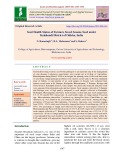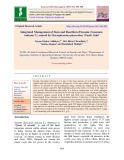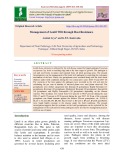
Seed borne infection
-
The present investigation on different seed health testing was undertaken during 20012-13 at Department of Plant Pathology, College of Agriculture, Bijapur, UAS, Dharwad. Among six different seed health testing methods used to assess their efficacy and reliability, standard blotter method was found to be good for the detection of seed borne infection of A. sesami in sesame.
 6p
6p  gaocaolon9
gaocaolon9
 22-12-2020
22-12-2020
 14
14
 1
1
 Download
Download
-
Black scurf of potato caused by Rhizoctonia solani is one of the most important disease in the category of soil and tuber borne disease especially in fungal group. Infested seed tubers are the main source of infection. Boric acid and pencycuron are the two chemicals which are frequently used by the Indian farmers to control black scurf of potato.
 6p
6p  trinhthamhodang1215
trinhthamhodang1215
 23-09-2020
23-09-2020
 15
15
 2
2
 Download
Download
-
The present investigations was carried out to study the effect of hot water seed treatment comprised of different ranges of temperature (47-49, 50-52 and 53-55 °C) and discrete duration of time (30, 45 and 60 min.). The seeds of bell pepper and their most important seed-borne pathogens (Alternaria spp., Curvuleria spp., Penicillium spp., Fusarium spp. Colletotrichum spp.) have been investigated in laboratory. Thee numbers of infected seeds were observed and recorded daily and per cent incidence was evaluated.
 8p
8p  caygaocaolon6
caygaocaolon6
 30-07-2020
30-07-2020
 12
12
 1
1
 Download
Download
-
The scanning electron micrograph of various fungi growing over sorghum and wheat seeds showed that, the conidia of Curvularia lunata were slightly curved, three septate, central cell were broad having surface ornamentation, darker than the end cell and arranged on sympodially branched conidiophores on sorghum seed.
 6p
6p  trinhthamhodang5
trinhthamhodang5
 16-05-2020
16-05-2020
 11
11
 1
1
 Download
Download
-
Fifty seed of sorghum, wheat and pearlmillet from infected seed lot having characteristics symptom of seed borne fungi. Seed of such symptoms got infected of Curvularia lunata, Bipolaris sorghicola and B. sorokiniana infected seed of sorghum wheat and pearlmillet. Histopathology of apparently in infected seeds confined to mycelium fragments of Curvularia lunata in seed coat and endosperm, embryonic region of sorghum, wheat and pearlmillet seed. Sorghum and pearlmillet seed indicates the presence of brown coloured thicks mycelial fragment of Bipolaris sorghicola in pericarp and embryo region.
 5p
5p  trinhthamhodang5
trinhthamhodang5
 16-05-2020
16-05-2020
 10
10
 1
1
 Download
Download
-
Mungbean is grown principally for its protein content. Seed borne mycoflora affect the germination and vigour of seeds. Seed health is an important factor in the control of diseases, since an infected seed is less viable, has low germination, reduced vigour and reduced yield.
 10p
10p  trinhthamhodang5
trinhthamhodang5
 16-05-2020
16-05-2020
 9
9
 1
1
 Download
Download
-
Chickpea seed were bioprimed with vermiculite and later with biocontrol agents for their efficacy on seed borne infections and seedling vigour of the plant. Among the seven treatments tested, the treatment P. fluorescens @ 0.8 % + T. harzianum@ 0.8 % + Vermiculite shown the least seed infection of 13.00 per cent, highest seed germination of 91.00 per cent and vigour index of 1753.
 5p
5p  kethamoi4
kethamoi4
 16-04-2020
16-04-2020
 7
7
 1
1
 Download
Download
-
During the present investigation yellow vein mosaic disease in bhendi (Abelmoschus esculentus (L.) Moench) caused by a whitefly Bemisia tabaci (Gennadius) (Hemiptera: Aleyrodidae) transmitted Begomovirus particularly Bhendi yellow vein mosaic virus [INNVS-2018] or BYMV [IN-NVS-2018] or BYMV was characterized by symptoms of homogenous interwoven network of yellow veins enclosing islands of green tissues.
 7p
7p  caygaocaolon4
caygaocaolon4
 04-04-2020
04-04-2020
 13
13
 2
2
 Download
Download
-
Rhizoctonia solani causing sheath blight of rice is reported to survive through soil and collateral hosts. Although it infects seed in field, role of seed-borne inoculum in disease development is not properly understood. However, only little information is available on the role of seed-borne inoculum in disease development in the field (Roy, 1989; Acharya and Gupta, 1996; Silvalingam et al., 2006). During the present investigation seed samples of two varieties were collected from healthy seeds (i.e. seeds harvested from healthy plant panicles) and diseased seeds (i.e.
 14p
14p  caygaocaolon2
caygaocaolon2
 14-03-2020
14-03-2020
 9
9
 0
0
 Download
Download
-
Seed health testing to detect seed-borne pathogens is an important step in the management of crop diseases. Laboratory experiments were carried out at College of Agriculture, Bhawanipatna during Kharif, 2018 to investigate the planting value of the seed and extent of seed-borne fungal pathogen problems from farmers saved seeds in Western undulated Zone of Odisha. A total number of six seed samples of Sesame were collected from farmers saved seeds in M. Rampur, Karlapada, Bhawanipatna, T. Rampur, Kesinga and Narla block of Kalahandi districts.
 6p
6p  chauchaungayxua3
chauchaungayxua3
 07-02-2020
07-02-2020
 14
14
 0
0
 Download
Download
-
Pythium damping-off of Chilli (Capsicum annuum L.) is very common problem in fields and greenhouses, whereas the organism kills newly emerged seedlings. In present investigation repeated isolations from rotten seeds as well as toppled seedlings of Chilli cv. Pusa Jwala have yielded the cultures of P. aphanidermatum. The damping off mainly being soil borne, the primary infections are needed to be controlled with suitable fungicides. The different fungicides and bioagents were evaluated as seed dressers and soil drenching.
 12p
12p  chauchaungayxua3
chauchaungayxua3
 07-02-2020
07-02-2020
 13
13
 0
0
 Download
Download
-
Sesame (Sesamum indicum L.) is one of the most ancient oil seed crop cultivated in tropical and sub-tropical countries. Irrespective of the agro-climate conditions, sesame is liable to be infected by various pathogenic fungi. Among the fungal diseases, stem and root rot of sesame caused by Macrophomina phaseolina affects severely at all stages of crop growth. Macrophomina phaseolina is a diverse, omnipresent soil borne pathogen. The pathogen survives as sclerotia in the soil and in host tissue for varying periods.
 5p
5p  kethamoi2
kethamoi2
 15-12-2019
15-12-2019
 15
15
 0
0
 Download
Download
-
Seed is the custodian of the genetic, potential of any cultivar and determines the limits of productivity in any cropping system. So awareness for seed health has increased among the growers, traders and consumers in recent years. A seed-borne inoculum not only secures the presence of a virulent strain of the pathogen along the seed but also favors the earliest possible establishment of the infection in seedlings along with possible threat of introduction of new physiological races/stains with seed.
 6p
6p  kequaidan2
kequaidan2
 11-12-2019
11-12-2019
 12
12
 0
0
 Download
Download
-
Lentil (Lens culinaris) is affected by the wilt disease caused by fungal pathogen Fusarium oxysporum f.sp. lentis at seedling stage and at the later stages of growth. The pathogen is soil and seed borne in nature and reported from all lentil growing areas. The present investigation is on the management of the lentil wilt pathogen by exploiting the resistance mechanism of the host. Ninety two germplasms were screened along with the local check (Sehore) under field conditions during the two consecutive years 2016-17 and 2017-18.
 7p
7p  kequaidan2
kequaidan2
 11-12-2019
11-12-2019
 15
15
 1
1
 Download
Download
-
Out of twelve fungicides and three bio-agents screened in the laboratory, Bavistin, Indofil M-45, Chlorothalonil, Vitavax and Thiram proved most effective as they caused total inhibition of the pathogen. Indofil Z-78, Captafol, Ziram, Captan and Blitox-50 were also found to be significantly superior compared to other fungicides. Out of five seed dressing fungicides and three bio-agents, Trichoderma viride proved to be the most effective followed by Trichoderma harzianum, Bavistin and Thiram in controlling the seed –borne infection of Alternaria alternata.
 10p
10p  nguaconbaynhay1
nguaconbaynhay1
 04-12-2019
04-12-2019
 16
16
 1
1
 Download
Download
CHỦ ĐỀ BẠN MUỐN TÌM








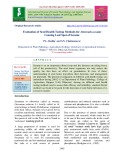

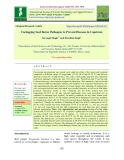

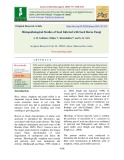
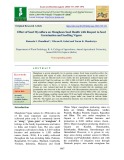
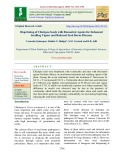
![Detection of bhendi yellow vein mosaic virus (byvmv) from the different parts of bhendi [Abelmoschus esculentus (L.) Moench] plant, flower and seed Detection of bhendi yellow vein mosaic virus (byvmv) from the different parts of bhendi [Abelmoschus esculentus (L.) Moench] plant, flower and seed](https://tailieu.vn/image/document/thumbnail/2020/20200404/caygaocaolon4/135x160/7671585938888.jpg)

